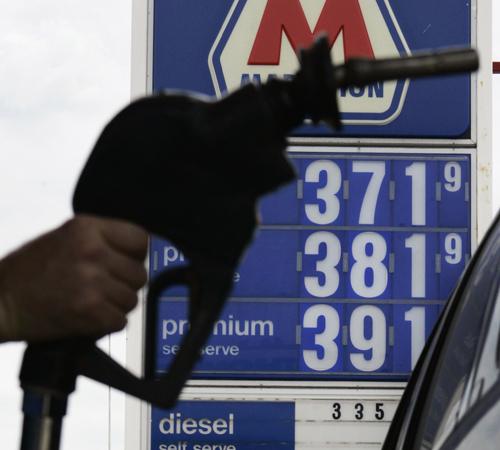POLL: More worry of financial hardship from gas prices, amid signs of growing acceptance

A gas pump nozzle is silhouetted against a gas price sign showing prices over $3.70 at a station near downtown Chicago Tuesday, May 15, 2007, as prices continued to soar. Most Americans are locked in to their driving habits, and can do little to alter the The Associated Press
May 25, 2007
Last updated on May 12, 2016 at 12:05 p.m.
WASHINGTON – Nearly half the country thinks near-record gasoline prices will cause serious hardship, prompting ever more people to consider trading their gas guzzlers for more fuel-efficient cars, an AP-Ipsos poll says.
Yet there are signs that more people also are clinging to their driving and vacation habits while grudgingly accepting the higher price tag. The government said this week that prices for a gallon of regular gasoline had hit a nationwide average of $3.22, nearly 50 percent higher than in January and pennies shy of the all-time mark.
Forty-six percent said they expect spiking gasoline prices to cause them severe financial problems, said the poll, released Friday at the Memorial Day weekend’s unofficial start of the summer driving season. That measure of public pocketbook pain is up slightly from last year and appreciably above the 30 percent figure of June 2004, when AP-Ipsos first asked the question.
Despite the skyrocketing cost, slightly fewer people than last year said they are reducing their driving, trimming other expenses or curtailing vacation plans due to higher energy costs. Asked to name a fair price for a gallon of gasoline, for the first time most volunteered $2 and up, and not less than $2.
Get The Daily Illini in your inbox!
“It’s worrisome, but I don’t feel I have much control over it,” said Ann Meyer, 39, a homemaker in Phoenix. “I guess I’m getting used to it.”
Clearly, rising prices are having a broad impact on people’s habits. The 47 percent who said they are considering buying a more fuel efficient car is up from 39 percent a year ago.
That could further feed a trend that has seen compact cars grow from about a fifth of the new car market in 2001 to nearly a third this year, according J.D. Power and Associates, which analyzes the automobile industry. Hybrids running on both gasoline and electricity now have 3.4 percent of the market, up from 0.4 percent in 2004.
Even so, fuel costs will have to approach $4 a gallon and stay there for about a year to trigger a major shift in consumer buying patterns, said Power automotive analyst Tom Libby, because many people expect this season’s sky-high gas prices to subside later, as they have before.
The government’s Energy Information Administration said last Monday’s average national price for regular gasoline of $3.22 a gallon came in just below the March 1981 all-time monthly high of $3.29, adjusted for inflation. It was actually selling for $1.42 at the time.
The Democratic-led House approved a bill this week outlawing price gouging. The White House threatened a veto, saying it amounted to price controls and would lead to long lines at gas pumps.
Gasoline consumption grew last week by 1.2 percent over the same period a year ago, as measured by four-week periods the agency calculates. That was slightly less than officials expected, which they attributed to the piercing of the psychological barrier of $3 per gallon.
“But it also wasn’t negative,” Doug MacIntyre, an oil market analyst at the agency, said of the slower growth. “We’re not seeing demand go down.”
Overall, when asked whether rising gasoline prices would cause financial hardship for them or their family over the next half year, seven in 10 said yes, about the same as last year. The number who foresaw a “serious hardship” was up from 43 percent to 46 percent.
Of those who said the higher costs would seriously hurt them, two-thirds said they compare prices before refilling their tanks – a practice about evenly shared among genders, races and income levels.
Seventy percent overall said they have tamped down their home heating or air conditioning, a slight increase from last May.
“We used to keep it lower in summer,” Pamela Diaz, 48, a homemaker in Plant City, Fla., said of her thermostat. “But everything is just so much. And it’s hot here in Florida.”
Large numbers of people were still taking other steps to save money due to energy price increases, yet fewer said so than a year ago. Those reducing their driving went from 66 percent last year to 62 percent now, including large proportions of women and older people.
Those changing vacation plans dropped from 49 percent in 2006 to 42 percent this year, while the number paring other expenses fell from 66 percent last year to 60 percent now.
Robert Gilliam, 40, an insurance claims adjuster from Clarksboro, N.J., said he now uses a sedan instead of a sport utility vehicle to save money for the 2,500 miles a month he drives for work. He said he is not cutting back on family vacation plans.
“That’s our one guilty pleasure,” he said.
Economics professor Peter Orazem of Iowa State University said gasoline costs are about 3 percent of the average household’s budget, so even stark increases in gas prices have a muffled impact on people’s overall expenditures.
In the poll, 40 percent said the fair price for a gallon is less than $2, down from 49 percent a year ago. This year, 49 percent said a fair price for a gallon is $2 to $2.99, with another 6 percent naming even higher prices.
“Markets can train us over time to get used to things,” said Tim Heath, marketing professor at Miami University of Ohio.
The AP-Ipsos poll involved telephone interviews with 1,000 randomly chosen adults between May 15 and 17. The margin of sampling error was plus or minus 3 percentage points.





